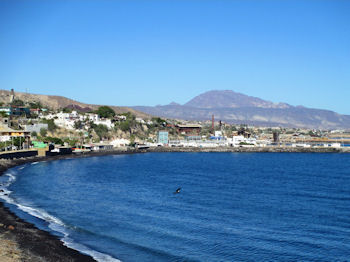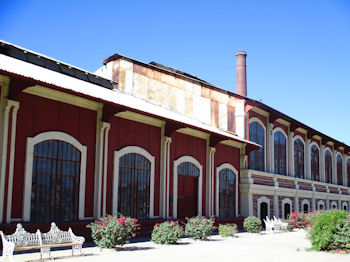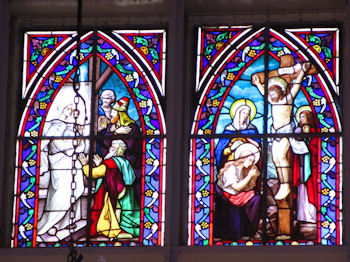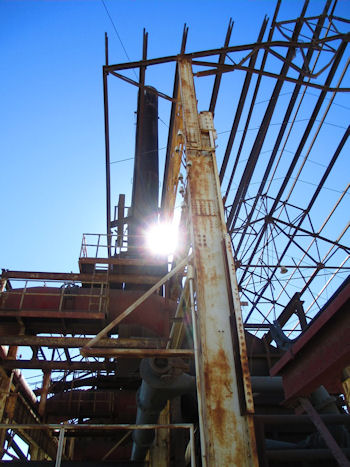 |  |
By Martina

Heading to Santa Rosalia from San Ignacio, there is nothing like the long drive across the Vizcaíno Biosphere Reserve. Passing by the volcanic range of Tres Virgenes, I come to the edge of the desert and it is like dropping over into the cerulean blue of the Gulf of California. The breathtaking descent curls around the sandstone cliffs to sea level. The wind whips the deep blue waters creating a few white caps on this winter day. Harrowing as it might seem, Mexico's road builders actually did a fine job taking the panic out of the hairpins. Before the road work, it was truly terrifying. I did a little fun research and came up with the incline gradient being about 35%. But don't hold me to it, it could be 40%. It is an exciting part of the journey taking the traveler deeper into Baja Sur.
Santa Rosalia has a colorful history. However, before written history, the Cochimi Indians were recording their own life on the walls of caves and leaving behind fanciful painting on stones. All along the gulf the Indians lived for thousands of years, fishing the rich waters and gathering native plants. The bays were natural protection from fierce northern winds and destructive hurricanes. These naturally became fishing villages where children were born and raised and when the missionaries arrived they found communities. With the discovery of small green nuggets their pastoral life changed forever. Copper had been found in Baja California Sur.

The French took to the idea of mining for the copper. In 1883 ships continually arrived from Europe bringing engines, rails and railway cars. From Canada and Oregon lumber was shipped creating a distinctive French influence in their homes. From 1870 to 1884 it has been recorded that 42,000 tons of copper had been mined. Southern Baja had its own gold rush during this time and records show that 6,000 ounces of gold had been extracted.
French influence can be seen in many different ways, the most obvious is the use of wood to construct the homes and businesses. There is still the old world touch of wooden porches and gingerbread décor inspired by the owners of the Boleo mining company. By one historian's account, "Santa Rosalia became a dynamic and versatile place. It loved music and formed orchestras. They had a theater where they showed French movies and was a place of clashing contrasts and situations. It had a scarred backdrop of copper hills, a black-tinted shore, French silks, fine perfumes, crystal, Bordeaux wines and combining all of this with flour tortillas, giant lobsters, abalone and chimney dust."
In the 1950s with a structure 60 years old and production falling off to 4%, the company compensated the remaining workers, gave away the old wood houses, and El Boleo shut down. What remains is an interesting walk through mining history. Left behind were the hulking metal structures housing massive steam generators and abandoned buildings. The city has created a park like setting. Today, Baja Mining, operates the new venture north of town. Copper, cobalt, zinc, manganese are being extracted. Korea is a major player. They went into full underground production in March 2013.

The Santa Barbara church in the center of town is not considered part of the historic Mision trail. Gustav Eiffel, architect of the Eiffel Tower took first place for both this church and the tower at the 1880 World Fair in Paris. Carlos La Frogue, acquired the church and he had its metal plates shipped individually to be reconstructed in Santa Rosalia. High above over the altar is an intense stain glass depicting Christ's death. The church was blessed and put under the protection of the miners' patron saint, Santa Barbara. The dark wooden pews and golden light from the street level windows create an interior warmth that beckons the faithful.
If the traveler has a hankering for good coffee, Boca 2 is found just as you come into town. Serving rich cappuccinos and providing internet access, it is a very popular local hang out. Sandwiches, salads, pizza and a Mexican favorite, different fruit flavored "aguas." Agua de sandía, watermelon water, is especially nice on a hot day.
Here at the main entrance there is an lively intersection with 6 streets meeting and flowing together all at once. This without benefit of signage. Somehow everyone seems to sort it all out without even a horn honking. Streets are narrow and all one way. Just notice which direction the cars are parked and choose according to the direction. Park and take a sight-seeing walk through the meandering streets lined with quaint French storefronts. Or drive past the main entrance to town and park along the embarcadero. The water is so blue and the walkways around the docks brilliant white, you could almost imagine you were in the Mediterranean. Add the black sand beaches and you have something very exotic. The Harbor Master is housed in one of the buildings, as is the bus stop and ferry to Guaymas. For a real adventure, you can take the ferry to mainland Mexico. However, from the Baja side you can only leave at 8 at night, Wednesday, Friday and Sunday. A ticket is $680 pesos or about US $56. Just south of town there are several nice hotels with views of the gulf and providing quiet ambiance. You can rest up before heading south to Mulege and some of the most exquisite beaches on the planet.


Martina's email: mteomaya(at)gmail.com

Great service, quick response time.

Very excellent service, needed insurance for Mexico, price was fair. The custumer service rep was...

Quick, easy and gr8 pricing .